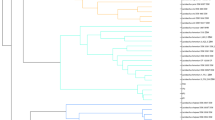Abstract
Twenty-three of 86 strains of lactic acid bacteria transformed linoleic acid into hydroxy FA. Two distinct conversion pathways were in operation. Two strains of Lactobacillus acidophilus and a strain of Pediococcus pentosaceus produced 13(S)-hydroxy-9-octadecenoic acid [13(S)-OH 18∶1] and 10,13-dihydroxyoctadecanoic acid (10,13-OH 18∶0) as main and minor products, respectively, whereas 13 strains, including L. casei subsp. casei, L. paracasei subsp, paracasei, L. rhamnosus, L. lactis subsp. cremoris, and Streptococcus salivarius subsp. thermophilus produced 10-hydroxy-12-octadecenoic acid (10-OH 18∶1). Seven strains of L. plantanum converted linoleic acid to 10-hydroxyoctadecanoic acid (10-OH 18∶0) through 10-OH 18∶1 Linoleic acid at 2 g/L was converted by L. acidophilus LFO13951T to 1.3 g of 13(S)-OH 18∶1 and 0.09 g of 10,13-OH 18∶0 in 7 d. Lactobacillus paracasei subsp. paracasei JCM 1111 produced 10-OH 18∶1 in 91% yield, and L. plantarum JCM 8341, 10-OH 18∶0 in 59% yield from linoleic acid (2 g/L) under optimal conditions. To our knowledge, this is the first report on the production of 13(S)-OH 18∶1 by lactic acid bacteria other than ruminal bacteria, and of 10,13-OH 18∶0 by any bacteria.
Similar content being viewed by others
Abbreviations
- 10-OH 18∶0:
-
10-hydroxyoctadecanoic acid
- 10-OH 18∶1:
-
10-hydroxy-12-octadecenoic acid
- 10,13-OH 18∶0:
-
10,13-dihydroxyoctadecanoic acid
- 13(S)-OH 18∶1:
-
13(S)-hydroxy-9-octadecenoic acid
- RT:
-
retention time
References
Hou, C.T. (1982) Microbial Transformation of Bioactive Compounds, pp. 81–107, CRC Press, Boca Raton, FL.
Ogawa, J., Matsumura, K., Kishino, S., Omura, Y., and Shimizu, S. (2001) Conjugated Linoleic Acid Accumulation via 10-Hydroxy-12-octadecaenoic Acid During Microaerobic Transformation of Linoleic Acid by Lactobacillus acidophilus, Appl. Environ. Microbiol. 67, 1246–1252.
Yamada, Y., Uemura, H., Nakaya, H., Sakata, K., Takatori, T., Nagao, M., Iwase, H., and Iwadate, K. (1996) Production of Hydroxy Fatty Acid (10-hydroxy-12(Z)-octadecenoic acid) by Lactobacillus plantarum from Linoleic Acid and Its Cardiac Effects to Guinea Pig Papillary Muscles, Biochem. Biophys. Res. Commun. 226, 391–395.
Hudson, J.W., Morvan, B., and Joblin, K.N. (1998) Hydration of Linoleic Acid by Bacteria Isolated from Ruminants, FEMS Microbiol. Lett. 169, 277–282.
Koritala, S., and Bagby, M.O. (1992) Microbial Conversion of Linoleic and Linolenic Acids to Unsaturated Hydroxy Fatty Acids, J. Am. Oil Chem. Soc. 69, 575–578.
Hou, C.T. (1994) Conversion of Linoleic Acid to 10-Hydroxy-12(Z)-octadecenoic Acid by Flavobacterium sp. (NRRL B-14859), J. Am. Oil Chem. Soc. 71, 975–978.
Hou, C.T. (1996) A Novel Compound, 12,13,17-Trihydroxy-9(Z)-octadecenoic Acid, from Linoleic Acid by a New Microbial Isolate Clavibacter sp. ALA2, J. Am. Oil Chem. Soc. 73, 1359–1362.
Kim, H., Jang, H., and Hou, C.T. (2002) Effect of Metal Ions on the Production of Isomeric 9,10,13(9,12,13)-Trihydroxy-11E(10E)-octadecenoic Acid from Linoleic Acid by Pseudomonas aeruginosa PR3, Enzyme Microb. Technol. 30, 752–757.
Fox, S.R., Akpinar, A., Prabhune, A.A., Friend, J., and Ratledge, C. (2000) The Biosynthesis of Oxylipins of Linoleic and Arachidonic Acids by the Sewage Fungus Leptomitus lacteus, Including the Identification of 8R-Hydroxy-9Z,12Z-Octadecadienoic Acid, Lipids 35, 23–30.
Wanikawa, A., Shoji, H., Hosoi, K., and Nakagawa, K. (2002) Stereospecificity of 10-Hydroxystearic Acid and Formation of 10-Ketostearic Acid by Lactic Acid Bacteria, J. Am. Soc. Brew. Chem. 60, 14–20.
Elli, M., Zink, R., Reniero, R., and Morelli, L. (1999) Growth Requirements of Lactobacillus johnsonii in Skim and UHT Milk, Int. Dairy J. 9, 507–513.
Hansen, P.A., and Mocquot, G. (1970) Lactobacillus acidophilus (Moro) comb. nov., Int. J. Syst. Bacteriol. 20, 325–327.
Hou, C.T. (1995) Is Strain DS5 Hydratase a C-10 Positional Specific Enzyme? Identification of Bioconversion Products from α- and γ-Linolenic acids by Flavobacterium sp. DS5, J. Ind. Microbiol. 14, 31–34.
Author information
Authors and Affiliations
Corresponding author
About this article
Cite this article
Kishimoto, N., Yamamoto, I., Toraishi, K. et al. Two distinct pathways for the formation of hydroxy FA from linoleic acid by lactic acid bacteria. Lipids 38, 1269–1274 (2003). https://doi.org/10.1007/s11745-003-1188-4
Received:
Revised:
Accepted:
Issue Date:
DOI: https://doi.org/10.1007/s11745-003-1188-4




